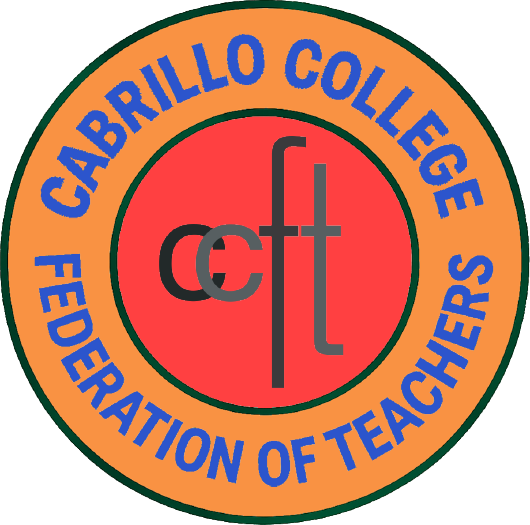Conrad Scott-Curtis
Original Assumptions Projected a Deficit of $13 Million by 2018-19; New Assumptions Project a Deficit of $3 Million by the Same Year; CCFT Encouraged by New Opening in Dialogue; CCFT Request for a Review of a September Document Submitted to the Governing Board Makes the Difference
CCFT is encouraged by a document presented last week at CPC, a revision of the District’s budget planning assumptions for the next five years. And we are gratified that this revision grows out of the District’s having listened to the concerns about budget planning expressed by CCFT.
Each fall, the District submits its fiscal-year budget to the Governing Board for approval; this September, the Board received and approved Cabrillo’s 2015-16 budget.
As part of each budget submitted to the governing board, the district includes an appendix of multi-year budget planning assumptions: a summary of expected revenues and expenses over a three-, four-, or five-year period. Such projections are, perforce, inaccurate, but they should provide a general picture of trends.
CCFT has long thought that the District’s budget-planning assumptions are less accurate than they could be. For example, over the past three years, the difference between projected budget and actual end-of-year have been about $4 million, $2.6 million, and $3.1 million.
One of the problems with the college’s assumptions has been that, while expenses are estimated out a number of years in some detail, revenues for the future have been left largely as question marks. The District’s rationale for this practice has been that we know, roughly, what our expenses will be over a period of years, but we don’t know how revenue might change in categories like COLA, base-budget allocation from the state, and so on. However, as we know, expenses tend to increase. And if we leave out any projection of change in revenues, that increase in expenses leads to projection of deepening deficits. The problem is that these projections have proven to be quite inaccurate. If we take combined cumulative projected deficits from 2004-05 to 2014-15, we have a projection of about a $17 million deficit. Looking at actuals over the same period, we have a surplus of about $13 million.
Understandably, governing-board members, when faced with a spreadsheet that shows dizzying growth in deficits, feel they must stem the tide however they might. At a minimum, such budget projections do not lead to “tranquil” reflection (if this one-time Wordsworth scholar might be permitted the allusion). Rather, it is our belief that inaccurate projections tend to stifle meaningful discussion.
Problems with This Year’s Projections Exacerbated by (Understandable) Error
All the better, then, that after a frank presentation by CCFT at the October meeting of the Governing Board, the District, rather than turning away from dialogue, took another look at their assumptions and revised them. CCFT welcomes this constructive step in communication.
In particular, problems with this year’s projections were exacerbated by an error in data entry, which CCFT identified. As you know, CalSTRS payments from the District pose a significant challenge over the next several years. Districts throughout the state will see an increase in annual contributions rise from 8.25% of payroll in 2013-14, to a daunting 19.10% in 2020-21. For Cabrillo, this means an increase of approximately $470,000 each year through 2018-19.
However, the September 8 document that went to the board showed each year’s CalSTRS payment increasing by the cumulative amount, rather than the year-over-year amount, leading to an approximately $3- million overestimate of contributions by the year 2018-19. Certainly, such an error is understandable (it’s a matter of percentage-point increases shown on one chart and entered into another) and would have been caught eventually, but the earlier the better, and the more accurate the conversation.
In addition to the problem with the STRS line, CCFT raised other questions: whether we might include among revenues some allocation changes from the state for the coming year, which we had reasonable estimates about, and whether we might include projections for not-for-credit revenue increases over several years. The new budget assumption document does both, and includes estimates for COLA increases over several years, which had not been included before. Again, thank you to the District for reconsidering.
We have also asked that the District consider projections of strong state revenues continuing over the next fiscal year and the movements afoot to replace and extend funding measures put in place by Prop. 30.
Now, a word of caution: the fact that we now have set of assumptions that we consider more reasonable than earlier examples is not a guarantee that the District will be in a position to make large advances in compensation over the next few years. We still face uncertainties regarding this year’s cuts due to enrollment decline; Proposition 30 sunsets in the not-too-distant future and we won’t know the outcome of ballot measures being registered now to extend that education-saving lifeline of funding until at least November 2016; we don’t know what the economy holds over the next few years.
However, are encouraged by the District’s showing of a strong interest in strengthening the basis for reasonable and good-faith discussion for the good of Cabrillo College and its students as we move forward.








